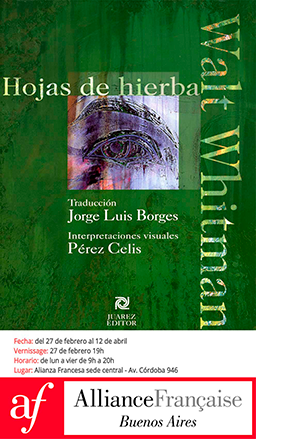THE WANDERING STORIES OF CECILIA PAREDES, IN BLANCA BERLIN
From her different interdisciplinary perspectives, Cecilia Paredes (Lima, Peru, 1950) lands in Blanca Berlin with a collection of images that deal with imaginary cartographies, displacements and human relations in their conceptual part, materialized, above all, on canvas as the main exhibition material. In Historias errantes (Wandering Stories), the Peruvian artist bets on recovering graphic materials anchored in antiquity, such as astrological charts, engravings of discoveries and maps, which become, after the manipulation of the parts, absolute compositions of impossible -but also aesthetic- iconography.
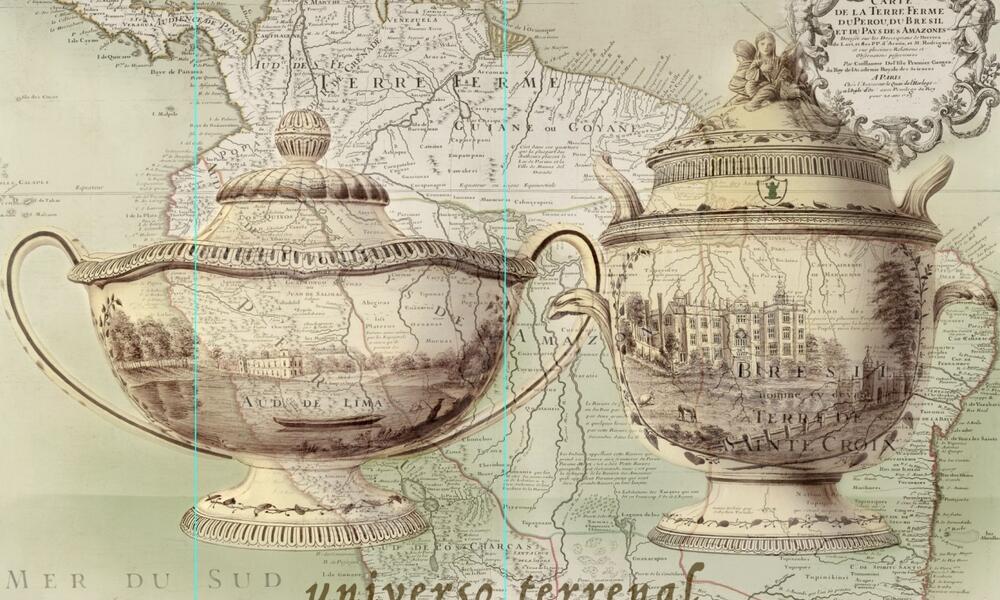
Although his most (re)known work wanders through other technical territories, the presence of his most recent production in this show delves into that aspect of handling embroidery and fabric as another alternative to express the areas in which he develops his work and that he already showed in a similar way in his proposal Celestials (2018).
Paredes has been working for a long time with colonialism, travel, the past and memory, axes that underlie these Historias errantes and that reconstruct and recover not only that more instrumental vision, but that part that corresponds to the objects with which he operates of a certain sentimental, archaic, certainly historical substrate, but of enormous beauty and artistic value, as well as of undoubted recoverer of memory.
The result of the series Mito y memoria (Myth and Memory), the main skeleton that vertebrates the route proposed by the gallery, recalls styles and perceptions far away in time and plays with the anachronism of them as the main vector to position itself in its intention to make understand the value of temporal references and the behavior of them in places and moments that do not correspond to them. They are imagined lexicons, symbols of the past that may have lost their original function, but that, in no case, have abandoned their aesthetic facet.
There are dialogues between pieces of other equally novel proposals to her credit that are interspersed in the process to enrich the understanding of the artist's vision. The two pieces of Maneras de ver el cielo (Different Ways to See the Sky) also serve as a cartography of diversity, of the cosmos that grows in the relationships and behavior of a diversity seen in perspective, while the pair of Apuntes personales (Personal Notes), with a more personal and subjective intrinsic story, reinforces the idea of the textile as a representation of the tangible, but also of the metaphor of intertwining, the same that the viewer approaches when confronted with the totality of this proposal.
-
Cecilia Paredes. Apuntes Japón I, 2024
-
Cecilia Paredes. Apuntes Japón I, 2024
-
Cecilia Paredes. Apuntes Japón II
-
Cecilia Paredes. Carta universal de la tierra, 2024. Cortesía Blanca Berlín
-
Cecilia Paredes. Maneras de ver el cielo, 2024. Cortesía Blanca Berlín
-
Cecilia Paredes. Paraíso perdido, 2024. Cortesía Blanca Berlín
-
Cecilia Paredes. Universo terrenal, 2024. Cortesía Blanca Berlín
Historias errantes can be seen until November 2 at Blanca Berlin Gallery, Limón, 28, Madrid (Spain).
Related Topics
May interest you

The two venues of MEMORIA gallery enter into a necessary dialogue by hosting the individual but connected exhibitions of Gustavo Pérez (Mexico City, Mexico, 1950) and Lin Calle (Hubei, China, 1994), who put on the table, from their techniques and perspectives, a debate of thought on the impoverishment and extinction of contemporary imaginaries.
GUSTAVO PÉREZ AND LIN CALLE CONNECT IN THE ARBOREAL, IN MEMORIAM
The two venues of MEMORIA gallery enter into a necessary dialogue by hosting the individual but connected exhibitions of Gustavo Pérez (Mexico City, Mexico, 1950) and Lin Calle (Hubei, China, 1994), who put on the table, from their techniques and perspectives, a debate of thought on the impoverishment and extinction of contemporary imaginaries.

The two venues of MEMORIA gallery enter into a necessary dialogue by hosting the individual but connected exhibitions of Gustavo Pérez (Mexico City, Mexico, 1950) and Lin Calle (Hubei, China, 1994), who put on the table, from their techniques and perspectives, a debate of thought on the impoverishment and extinction of contemporary imaginaries.
GUSTAVO PÉREZ AND LIN CALLE CONNECT IN THE ARBOREAL, IN MEMORIAM
The two venues of MEMORIA gallery enter into a necessary dialogue by hosting the individual but connected exhibitions of Gustavo Pérez (Mexico City, Mexico, 1950) and Lin Calle (Hubei, China, 1994), who put on the table, from their techniques and perspectives, a debate of thought on the impoverishment and extinction of contemporary imaginaries.
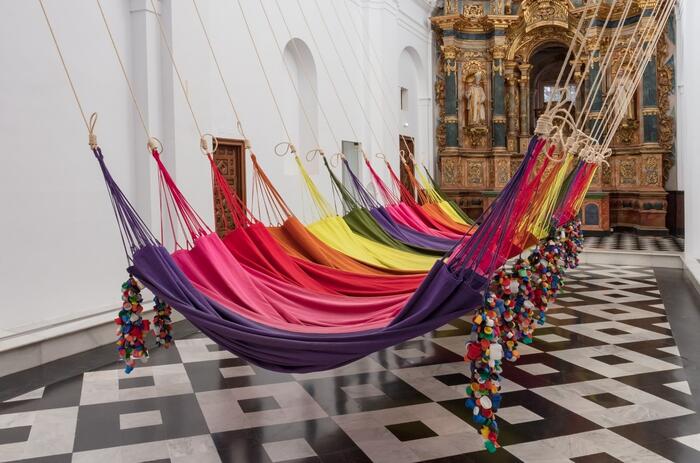
The artistic collective from Rio de Janeiro OPAVIVARÁ! intervenes in the space of the Capilla de Afuera of the Centro Andaluz de Arte Contemporáneo in Seville with its Rede social, a sensorial and materialized symbology with which the Brazilians invite the spectator to place himself in a position to negotiate and cooperate with his fellow men and women. The intervention, consisting of the unfolding of fabric hammocks that acquire the rhythm and cadence that the visitor imprints with his movement and presence and that adds sounds of snoring, follows the group's premise of building spaces and devices that offer a collaborative experience.
OPAVIVARÁ! INSTALLS ITS “SOCIAL NETWORK” IN THE CAAC
The artistic collective from Rio de Janeiro OPAVIVARÁ! intervenes in the space of the Capilla de Afuera of the Centro Andaluz de Arte Contemporáneo in Seville with its Rede social, a sensorial and materialized symbology with which the Brazilians invite the spectator to place himself in a position to negotiate and cooperate with his fellow men and women. The intervention, consisting of the unfolding of fabric hammocks that acquire the rhythm and cadence that the visitor imprints with his movement and presence and that adds sounds of snoring, follows the group's premise of building spaces and devices that offer a collaborative experience.
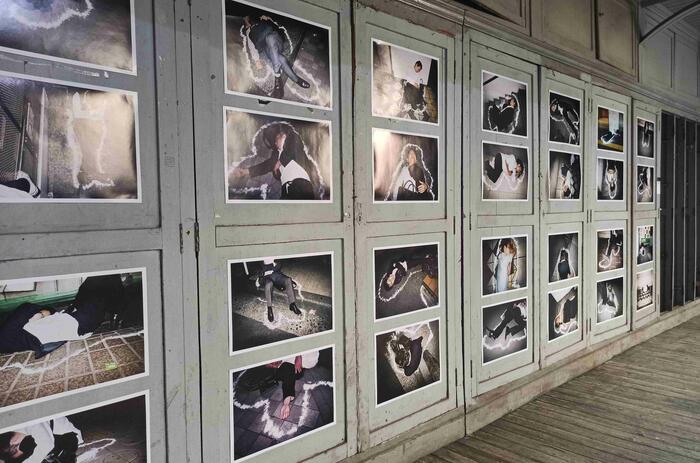
There seems to be, and increasingly so, a constant and growing debate in the social sphere about labor relations and the impact of work on people. Almost absolute concepts in current narratives such as work-life balance or resilience lack the necessary background to create that conversation. However, in order to build precisely on them, the research being done on the impact and culture of work in this new revision that Postmodernity leads to value proposals such as the one Allegra Pacheco (San Jose, Costa Rica, 1986) lands in her conceptual Dear Salaryman, which in its latest evolution is exhibited at the Museo La Neomudéjar in Madrid.
ALLEGRA PACHECO AND THE IMPACT OF THE LABOR ISSUE
There seems to be, and increasingly so, a constant and growing debate in the social sphere about labor relations and the impact of work on people. Almost absolute concepts in current narratives such as work-life balance or resilience lack the necessary background to create that conversation. However, in order to build precisely on them, the research being done on the impact and culture of work in this new revision that Postmodernity leads to value proposals such as the one Allegra Pacheco (San Jose, Costa Rica, 1986) lands in her conceptual Dear Salaryman, which in its latest evolution is exhibited at the Museo La Neomudéjar in Madrid.
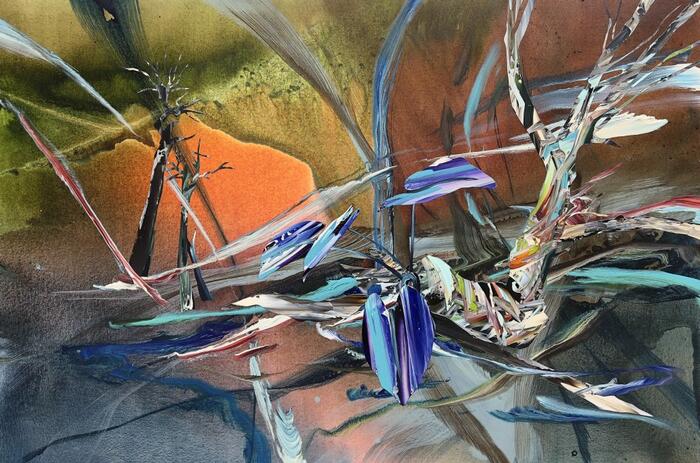
Germán Tagle (Santiago, Chile, 1976) returns to Madrid's Daniel Cuevas, where he held his first exhibition two years ago, with El territorio portátil, a show in which the Chilean artist returns to the axes of landscape, painting and culture that have been the backbone of his latest productions.
GERMÁN TAGLE'S REDEFINITION OF LANDSCAPE
Germán Tagle (Santiago, Chile, 1976) returns to Madrid's Daniel Cuevas, where he held his first exhibition two years ago, with El territorio portátil, a show in which the Chilean artist returns to the axes of landscape, painting and culture that have been the backbone of his latest productions.
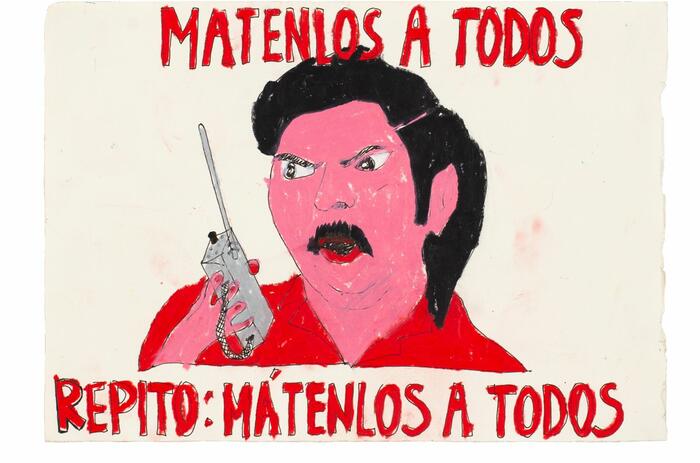
The double problem that arose from the acquisition in the 1980s of several hippopotamuses in one of the many eccentricities of the trafficker Pablo Escóbar is the starting point of a fable that, between the tragic and the comic, Camilo Restrepo (Medellín, Colombia, 1975) has managed to weave with a very successful graphic and conceptual narrative. With Cocaine Hippos Sweat Blood, the spectator faces this surrealistic story from its beginnings to the present by the hand of a figurativism that sets aside the academic and the technical for the sake of a greater aesthetic and relational concordance with that of the madness transmitted by the story itself.
THE NARCO-HYPOPOTAMUSES’ TALE, BY CAMILO RESTREPO
The double problem that arose from the acquisition in the 1980s of several hippopotamuses in one of the many eccentricities of the trafficker Pablo Escóbar is the starting point of a fable that, between the tragic and the comic, Camilo Restrepo (Medellín, Colombia, 1975) has managed to weave with a very successful graphic and conceptual narrative. With Cocaine Hippos Sweat Blood, the spectator faces this surrealistic story from its beginnings to the present by the hand of a figurativism that sets aside the academic and the technical for the sake of a greater aesthetic and relational concordance with that of the madness transmitted by the story itself.
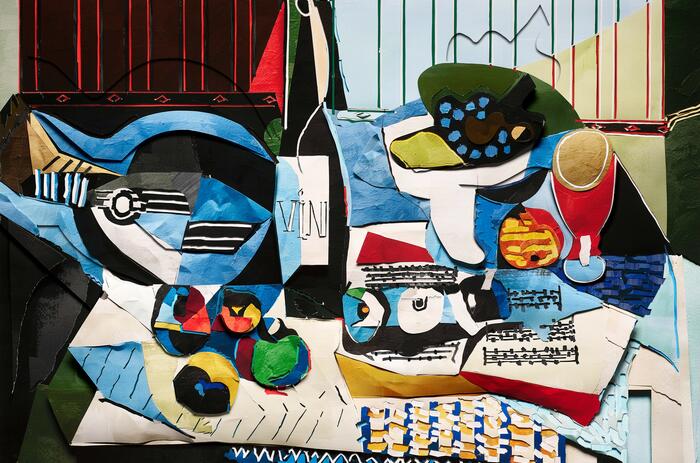
Madrid's Elba Benitez gallery has entrusted Vik Muniz (Sao Paulo, Brazil, 1961) with its first exhibition of the new season. Entitled Photocubism, the proposal is based on art historiography itself, recovering the cubist aesthetics as a substratum of the technical intervention he makes on iconic works of this movement. The Brazilian artist thus opts for this language to obtain new images that raise questions about perception and result.
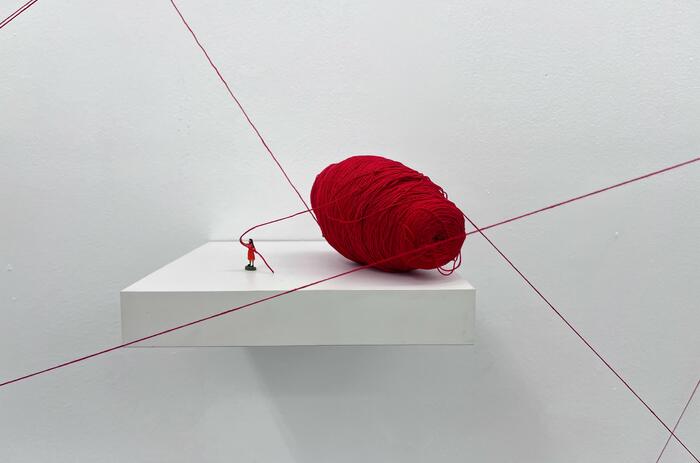
Liliana Porter (Buenos Aires, Argentina, 1941) has a long history shared with Espacio Minimo. The Madrid gallery pampers every move and celebrates the extensive relationship with the Argentinean artist, always offering her the possibility of receiving her work and witnessing its evolution. For the opening of the space's season, the landing is called Otros cuentos inconclusos, a new proposal that deals with representation and two dimensional axes —space and time— that bear witness to many of the questions raised about human relations.
THE UNFINISHED STORIES OF LILIANA PORTER
Liliana Porter (Buenos Aires, Argentina, 1941) has a long history shared with Espacio Minimo. The Madrid gallery pampers every move and celebrates the extensive relationship with the Argentinean artist, always offering her the possibility of receiving her work and witnessing its evolution. For the opening of the space's season, the landing is called Otros cuentos inconclusos, a new proposal that deals with representation and two dimensional axes —space and time— that bear witness to many of the questions raised about human relations.
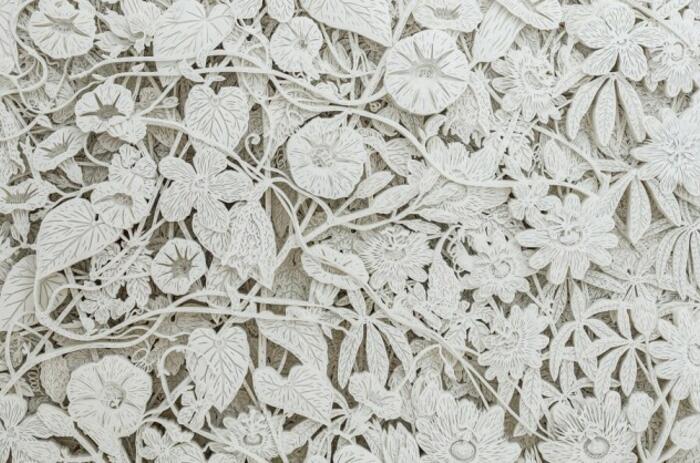
Cuban-born artist Ariamna Contino presents the exhibition Manigua at El Apartamento, in Spain to revisit the concept of “manigua”, a term historically used to refer to a tropical forest ecosystem.
ARIAMNA CONTINO: THE FOREST IS DISORDER, ABUNDANCE AND CONFUSION
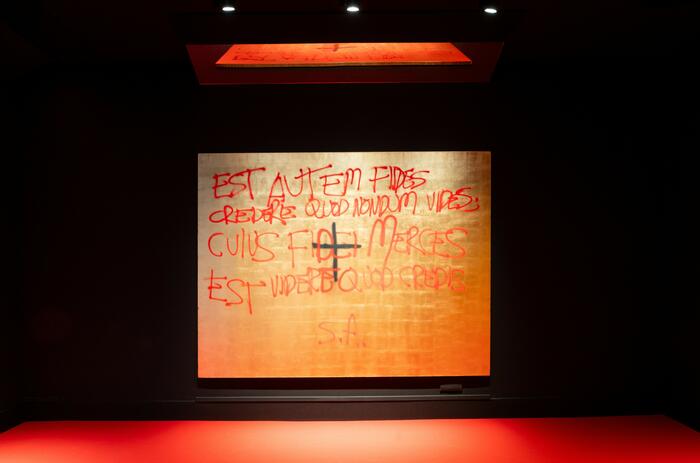
Stefan Brüggemann (Mexico City, Mexico, 1975) disembarks at Casa de México with Dos líneas (fe), a series that is understood as an installation and that starts from the impact and the apparent simplicity exposed to develop the concept of inheritance and its satellites. The Mexican conceptual artist uses the power reflected by symbols, religion and history, an element that he deploys, sometimes explicitly, in his large-format works.
STEFAN BRÜGGEMANN'S LINES OF FAITH, AT CASA DE MEXICO
Stefan Brüggemann (Mexico City, Mexico, 1975) disembarks at Casa de México with Dos líneas (fe), a series that is understood as an installation and that starts from the impact and the apparent simplicity exposed to develop the concept of inheritance and its satellites. The Mexican conceptual artist uses the power reflected by symbols, religion and history, an element that he deploys, sometimes explicitly, in his large-format works.
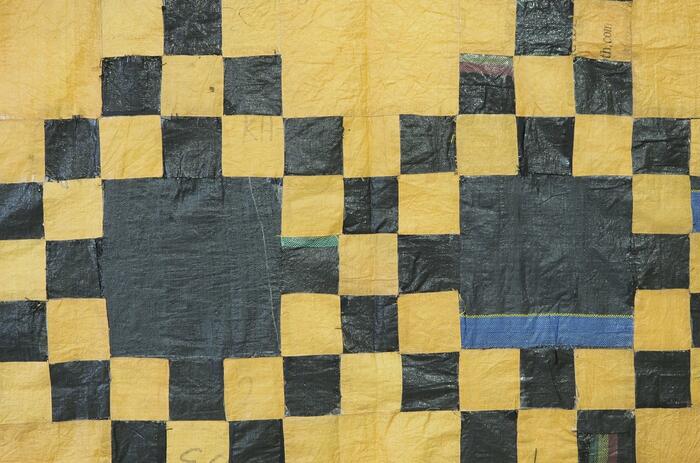
Casa de América is hosting three interconnected exhibitions in Madrid until November 30 that investigate and show the influence of the arts and the roots of pre-Columbian cultures in contemporary art and architecture.
THE PRE-COLUMBIAN ROOTS IN THE CONTEMPORARY, AT CASA DE AMERICA
Casa de América is hosting three interconnected exhibitions in Madrid until November 30 that investigate and show the influence of the arts and the roots of pre-Columbian cultures in contemporary art and architecture.
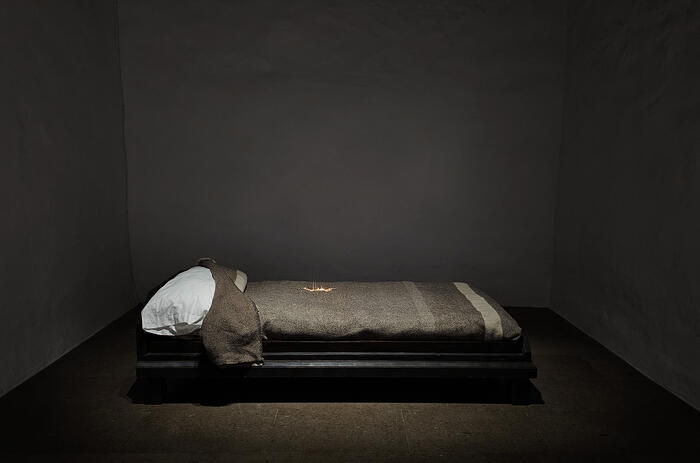
Pamen Pereira (Ferrol, Spain, 1963) unfolds her project Don't give up at Artizar gallery in Tenerife, a show made up of fourteen pieces that make up a total, but that must be seen from the prism of combination and language. However, the artist advocates for observing what is hidden behind the relationship of her works, the selection and the dialogue that the tour offers us.
PAMEN PEREIRA: SPACE, ORDER AND ELEMENTS, AT ARTIZAR
Pamen Pereira (Ferrol, Spain, 1963) unfolds her project Don't give up at Artizar gallery in Tenerife, a show made up of fourteen pieces that make up a total, but that must be seen from the prism of combination and language. However, the artist advocates for observing what is hidden behind the relationship of her works, the selection and the dialogue that the tour offers us.
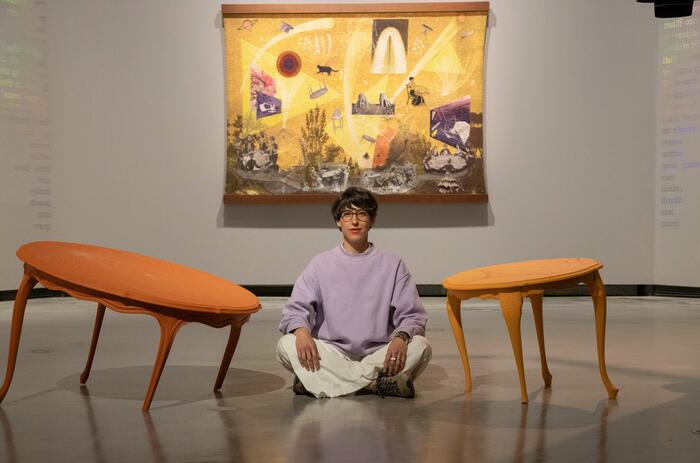
Mercedes Azpilicueta (La Plata, Argentina, 1981) lands with her dancing tables at the Centro de Creación Contemporánea de Andalucía (C3A) in an exhibition curated by Verónica Rossi and Jimena Blázquez. A visual and performance artist based in Amsterdam, her artistic practice proposes in her multi-layered works a meeting place between the past and the present through her protagonists and their expressions, some physical -but not corporeal-, such as voices; others, material, such as forms and texts; and others of a more intangible nature such as memory and remembrance.
MERCEDES AZPILICUETA AND HER “DANCING TABLES” IN C3A
Mercedes Azpilicueta (La Plata, Argentina, 1981) lands with her dancing tables at the Centro de Creación Contemporánea de Andalucía (C3A) in an exhibition curated by Verónica Rossi and Jimena Blázquez. A visual and performance artist based in Amsterdam, her artistic practice proposes in her multi-layered works a meeting place between the past and the present through her protagonists and their expressions, some physical -but not corporeal-, such as voices; others, material, such as forms and texts; and others of a more intangible nature such as memory and remembrance.
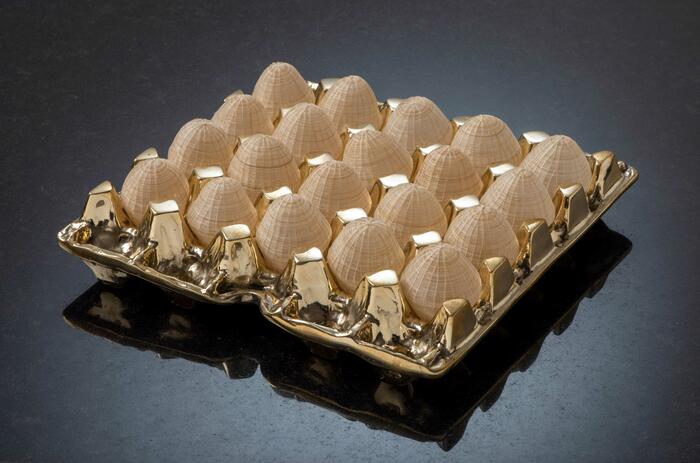
Rutas relacionales (Relational Routes) is the long-term collective with which the Lucía Mendoza gallery celebrates its tenth anniversary and with which it intends to raise awareness, through the work of about 40 artists, about several of the current thematic and philosophical axes, those that trace their need from the relationship of mankind with its environment. In these axes, we find lines of argument that deal with ecology, society and economies, passing through everything that composes them, such as political processes or the construction of identity.
"RELATIONAL ROUTES": THE LATIN AMERICAN COLLECTIVE EXHIBITION AT LUCÍA MENDOZA
Rutas relacionales (Relational Routes) is the long-term collective with which the Lucía Mendoza gallery celebrates its tenth anniversary and with which it intends to raise awareness, through the work of about 40 artists, about several of the current thematic and philosophical axes, those that trace their need from the relationship of mankind with its environment. In these axes, we find lines of argument that deal with ecology, society and economies, passing through everything that composes them, such as political processes or the construction of identity.
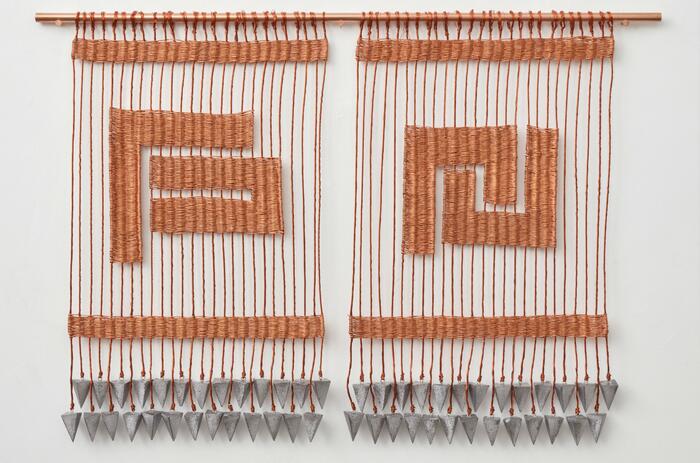
The Lima Museum of Art (MALI) announced the thirty-second edition of its annual auction, dedicated in this occasion to textile art, a heritage that played a fundamental role in Peru's cultural history. The event will take place on October 19 at the museum and will feature a selection of more than 70 pieces of art, from historic textiles to contemporary works.
MALI 2024 AUCTION: THE TEXTILE ART EDITION
The Lima Museum of Art (MALI) announced the thirty-second edition of its annual auction, dedicated in this occasion to textile art, a heritage that played a fundamental role in Peru's cultural history. The event will take place on October 19 at the museum and will feature a selection of more than 70 pieces of art, from historic textiles to contemporary works.

The two venues of MEMORIA gallery enter into a necessary dialogue by hosting the individual but connected exhibitions of Gustavo Pérez (Mexico City, Mexico, 1950) and Lin Calle (Hubei, China, 1994), who put on the table, from their techniques and perspectives, a debate of thought on the impoverishment and extinction of contemporary imaginaries.
GUSTAVO PÉREZ AND LIN CALLE CONNECT IN THE ARBOREAL, IN MEMORIAM
The two venues of MEMORIA gallery enter into a necessary dialogue by hosting the individual but connected exhibitions of Gustavo Pérez (Mexico City, Mexico, 1950) and Lin Calle (Hubei, China, 1994), who put on the table, from their techniques and perspectives, a debate of thought on the impoverishment and extinction of contemporary imaginaries.

The artistic collective from Rio de Janeiro OPAVIVARÁ! intervenes in the space of the Capilla de Afuera of the Centro Andaluz de Arte Contemporáneo in Seville with its Rede social, a sensorial and materialized symbology with which the Brazilians invite the spectator to place himself in a position to negotiate and cooperate with his fellow men and women. The intervention, consisting of the unfolding of fabric hammocks that acquire the rhythm and cadence that the visitor imprints with his movement and presence and that adds sounds of snoring, follows the group's premise of building spaces and devices that offer a collaborative experience.
OPAVIVARÁ! INSTALLS ITS “SOCIAL NETWORK” IN THE CAAC
The artistic collective from Rio de Janeiro OPAVIVARÁ! intervenes in the space of the Capilla de Afuera of the Centro Andaluz de Arte Contemporáneo in Seville with its Rede social, a sensorial and materialized symbology with which the Brazilians invite the spectator to place himself in a position to negotiate and cooperate with his fellow men and women. The intervention, consisting of the unfolding of fabric hammocks that acquire the rhythm and cadence that the visitor imprints with his movement and presence and that adds sounds of snoring, follows the group's premise of building spaces and devices that offer a collaborative experience.

There seems to be, and increasingly so, a constant and growing debate in the social sphere about labor relations and the impact of work on people. Almost absolute concepts in current narratives such as work-life balance or resilience lack the necessary background to create that conversation. However, in order to build precisely on them, the research being done on the impact and culture of work in this new revision that Postmodernity leads to value proposals such as the one Allegra Pacheco (San Jose, Costa Rica, 1986) lands in her conceptual Dear Salaryman, which in its latest evolution is exhibited at the Museo La Neomudéjar in Madrid.
ALLEGRA PACHECO AND THE IMPACT OF THE LABOR ISSUE
There seems to be, and increasingly so, a constant and growing debate in the social sphere about labor relations and the impact of work on people. Almost absolute concepts in current narratives such as work-life balance or resilience lack the necessary background to create that conversation. However, in order to build precisely on them, the research being done on the impact and culture of work in this new revision that Postmodernity leads to value proposals such as the one Allegra Pacheco (San Jose, Costa Rica, 1986) lands in her conceptual Dear Salaryman, which in its latest evolution is exhibited at the Museo La Neomudéjar in Madrid.

Germán Tagle (Santiago, Chile, 1976) returns to Madrid's Daniel Cuevas, where he held his first exhibition two years ago, with El territorio portátil, a show in which the Chilean artist returns to the axes of landscape, painting and culture that have been the backbone of his latest productions.
GERMÁN TAGLE'S REDEFINITION OF LANDSCAPE
Germán Tagle (Santiago, Chile, 1976) returns to Madrid's Daniel Cuevas, where he held his first exhibition two years ago, with El territorio portátil, a show in which the Chilean artist returns to the axes of landscape, painting and culture that have been the backbone of his latest productions.

The double problem that arose from the acquisition in the 1980s of several hippopotamuses in one of the many eccentricities of the trafficker Pablo Escóbar is the starting point of a fable that, between the tragic and the comic, Camilo Restrepo (Medellín, Colombia, 1975) has managed to weave with a very successful graphic and conceptual narrative. With Cocaine Hippos Sweat Blood, the spectator faces this surrealistic story from its beginnings to the present by the hand of a figurativism that sets aside the academic and the technical for the sake of a greater aesthetic and relational concordance with that of the madness transmitted by the story itself.
THE NARCO-HYPOPOTAMUSES’ TALE, BY CAMILO RESTREPO
The double problem that arose from the acquisition in the 1980s of several hippopotamuses in one of the many eccentricities of the trafficker Pablo Escóbar is the starting point of a fable that, between the tragic and the comic, Camilo Restrepo (Medellín, Colombia, 1975) has managed to weave with a very successful graphic and conceptual narrative. With Cocaine Hippos Sweat Blood, the spectator faces this surrealistic story from its beginnings to the present by the hand of a figurativism that sets aside the academic and the technical for the sake of a greater aesthetic and relational concordance with that of the madness transmitted by the story itself.

Madrid's Elba Benitez gallery has entrusted Vik Muniz (Sao Paulo, Brazil, 1961) with its first exhibition of the new season. Entitled Photocubism, the proposal is based on art historiography itself, recovering the cubist aesthetics as a substratum of the technical intervention he makes on iconic works of this movement. The Brazilian artist thus opts for this language to obtain new images that raise questions about perception and result.

Liliana Porter (Buenos Aires, Argentina, 1941) has a long history shared with Espacio Minimo. The Madrid gallery pampers every move and celebrates the extensive relationship with the Argentinean artist, always offering her the possibility of receiving her work and witnessing its evolution. For the opening of the space's season, the landing is called Otros cuentos inconclusos, a new proposal that deals with representation and two dimensional axes —space and time— that bear witness to many of the questions raised about human relations.
THE UNFINISHED STORIES OF LILIANA PORTER
Liliana Porter (Buenos Aires, Argentina, 1941) has a long history shared with Espacio Minimo. The Madrid gallery pampers every move and celebrates the extensive relationship with the Argentinean artist, always offering her the possibility of receiving her work and witnessing its evolution. For the opening of the space's season, the landing is called Otros cuentos inconclusos, a new proposal that deals with representation and two dimensional axes —space and time— that bear witness to many of the questions raised about human relations.

Cuban-born artist Ariamna Contino presents the exhibition Manigua at El Apartamento, in Spain to revisit the concept of “manigua”, a term historically used to refer to a tropical forest ecosystem.
ARIAMNA CONTINO: THE FOREST IS DISORDER, ABUNDANCE AND CONFUSION

Stefan Brüggemann (Mexico City, Mexico, 1975) disembarks at Casa de México with Dos líneas (fe), a series that is understood as an installation and that starts from the impact and the apparent simplicity exposed to develop the concept of inheritance and its satellites. The Mexican conceptual artist uses the power reflected by symbols, religion and history, an element that he deploys, sometimes explicitly, in his large-format works.
STEFAN BRÜGGEMANN'S LINES OF FAITH, AT CASA DE MEXICO
Stefan Brüggemann (Mexico City, Mexico, 1975) disembarks at Casa de México with Dos líneas (fe), a series that is understood as an installation and that starts from the impact and the apparent simplicity exposed to develop the concept of inheritance and its satellites. The Mexican conceptual artist uses the power reflected by symbols, religion and history, an element that he deploys, sometimes explicitly, in his large-format works.

Casa de América is hosting three interconnected exhibitions in Madrid until November 30 that investigate and show the influence of the arts and the roots of pre-Columbian cultures in contemporary art and architecture.
THE PRE-COLUMBIAN ROOTS IN THE CONTEMPORARY, AT CASA DE AMERICA
Casa de América is hosting three interconnected exhibitions in Madrid until November 30 that investigate and show the influence of the arts and the roots of pre-Columbian cultures in contemporary art and architecture.

Pamen Pereira (Ferrol, Spain, 1963) unfolds her project Don't give up at Artizar gallery in Tenerife, a show made up of fourteen pieces that make up a total, but that must be seen from the prism of combination and language. However, the artist advocates for observing what is hidden behind the relationship of her works, the selection and the dialogue that the tour offers us.
PAMEN PEREIRA: SPACE, ORDER AND ELEMENTS, AT ARTIZAR
Pamen Pereira (Ferrol, Spain, 1963) unfolds her project Don't give up at Artizar gallery in Tenerife, a show made up of fourteen pieces that make up a total, but that must be seen from the prism of combination and language. However, the artist advocates for observing what is hidden behind the relationship of her works, the selection and the dialogue that the tour offers us.

Mercedes Azpilicueta (La Plata, Argentina, 1981) lands with her dancing tables at the Centro de Creación Contemporánea de Andalucía (C3A) in an exhibition curated by Verónica Rossi and Jimena Blázquez. A visual and performance artist based in Amsterdam, her artistic practice proposes in her multi-layered works a meeting place between the past and the present through her protagonists and their expressions, some physical -but not corporeal-, such as voices; others, material, such as forms and texts; and others of a more intangible nature such as memory and remembrance.
MERCEDES AZPILICUETA AND HER “DANCING TABLES” IN C3A
Mercedes Azpilicueta (La Plata, Argentina, 1981) lands with her dancing tables at the Centro de Creación Contemporánea de Andalucía (C3A) in an exhibition curated by Verónica Rossi and Jimena Blázquez. A visual and performance artist based in Amsterdam, her artistic practice proposes in her multi-layered works a meeting place between the past and the present through her protagonists and their expressions, some physical -but not corporeal-, such as voices; others, material, such as forms and texts; and others of a more intangible nature such as memory and remembrance.

Rutas relacionales (Relational Routes) is the long-term collective with which the Lucía Mendoza gallery celebrates its tenth anniversary and with which it intends to raise awareness, through the work of about 40 artists, about several of the current thematic and philosophical axes, those that trace their need from the relationship of mankind with its environment. In these axes, we find lines of argument that deal with ecology, society and economies, passing through everything that composes them, such as political processes or the construction of identity.
"RELATIONAL ROUTES": THE LATIN AMERICAN COLLECTIVE EXHIBITION AT LUCÍA MENDOZA
Rutas relacionales (Relational Routes) is the long-term collective with which the Lucía Mendoza gallery celebrates its tenth anniversary and with which it intends to raise awareness, through the work of about 40 artists, about several of the current thematic and philosophical axes, those that trace their need from the relationship of mankind with its environment. In these axes, we find lines of argument that deal with ecology, society and economies, passing through everything that composes them, such as political processes or the construction of identity.

The Lima Museum of Art (MALI) announced the thirty-second edition of its annual auction, dedicated in this occasion to textile art, a heritage that played a fundamental role in Peru's cultural history. The event will take place on October 19 at the museum and will feature a selection of more than 70 pieces of art, from historic textiles to contemporary works.
MALI 2024 AUCTION: THE TEXTILE ART EDITION
The Lima Museum of Art (MALI) announced the thirty-second edition of its annual auction, dedicated in this occasion to textile art, a heritage that played a fundamental role in Peru's cultural history. The event will take place on October 19 at the museum and will feature a selection of more than 70 pieces of art, from historic textiles to contemporary works.

The two venues of MEMORIA gallery enter into a necessary dialogue by hosting the individual but connected exhibitions of Gustavo Pérez (Mexico City, Mexico, 1950) and Lin Calle (Hubei, China, 1994), who put on the table, from their techniques and perspectives, a debate of thought on the impoverishment and extinction of contemporary imaginaries.
GUSTAVO PÉREZ AND LIN CALLE CONNECT IN THE ARBOREAL, IN MEMORIAM
The two venues of MEMORIA gallery enter into a necessary dialogue by hosting the individual but connected exhibitions of Gustavo Pérez (Mexico City, Mexico, 1950) and Lin Calle (Hubei, China, 1994), who put on the table, from their techniques and perspectives, a debate of thought on the impoverishment and extinction of contemporary imaginaries.

The artistic collective from Rio de Janeiro OPAVIVARÁ! intervenes in the space of the Capilla de Afuera of the Centro Andaluz de Arte Contemporáneo in Seville with its Rede social, a sensorial and materialized symbology with which the Brazilians invite the spectator to place himself in a position to negotiate and cooperate with his fellow men and women. The intervention, consisting of the unfolding of fabric hammocks that acquire the rhythm and cadence that the visitor imprints with his movement and presence and that adds sounds of snoring, follows the group's premise of building spaces and devices that offer a collaborative experience.
OPAVIVARÁ! INSTALLS ITS “SOCIAL NETWORK” IN THE CAAC
The artistic collective from Rio de Janeiro OPAVIVARÁ! intervenes in the space of the Capilla de Afuera of the Centro Andaluz de Arte Contemporáneo in Seville with its Rede social, a sensorial and materialized symbology with which the Brazilians invite the spectator to place himself in a position to negotiate and cooperate with his fellow men and women. The intervention, consisting of the unfolding of fabric hammocks that acquire the rhythm and cadence that the visitor imprints with his movement and presence and that adds sounds of snoring, follows the group's premise of building spaces and devices that offer a collaborative experience.

There seems to be, and increasingly so, a constant and growing debate in the social sphere about labor relations and the impact of work on people. Almost absolute concepts in current narratives such as work-life balance or resilience lack the necessary background to create that conversation. However, in order to build precisely on them, the research being done on the impact and culture of work in this new revision that Postmodernity leads to value proposals such as the one Allegra Pacheco (San Jose, Costa Rica, 1986) lands in her conceptual Dear Salaryman, which in its latest evolution is exhibited at the Museo La Neomudéjar in Madrid.
ALLEGRA PACHECO AND THE IMPACT OF THE LABOR ISSUE
There seems to be, and increasingly so, a constant and growing debate in the social sphere about labor relations and the impact of work on people. Almost absolute concepts in current narratives such as work-life balance or resilience lack the necessary background to create that conversation. However, in order to build precisely on them, the research being done on the impact and culture of work in this new revision that Postmodernity leads to value proposals such as the one Allegra Pacheco (San Jose, Costa Rica, 1986) lands in her conceptual Dear Salaryman, which in its latest evolution is exhibited at the Museo La Neomudéjar in Madrid.

Germán Tagle (Santiago, Chile, 1976) returns to Madrid's Daniel Cuevas, where he held his first exhibition two years ago, with El territorio portátil, a show in which the Chilean artist returns to the axes of landscape, painting and culture that have been the backbone of his latest productions.
GERMÁN TAGLE'S REDEFINITION OF LANDSCAPE
Germán Tagle (Santiago, Chile, 1976) returns to Madrid's Daniel Cuevas, where he held his first exhibition two years ago, with El territorio portátil, a show in which the Chilean artist returns to the axes of landscape, painting and culture that have been the backbone of his latest productions.

The double problem that arose from the acquisition in the 1980s of several hippopotamuses in one of the many eccentricities of the trafficker Pablo Escóbar is the starting point of a fable that, between the tragic and the comic, Camilo Restrepo (Medellín, Colombia, 1975) has managed to weave with a very successful graphic and conceptual narrative. With Cocaine Hippos Sweat Blood, the spectator faces this surrealistic story from its beginnings to the present by the hand of a figurativism that sets aside the academic and the technical for the sake of a greater aesthetic and relational concordance with that of the madness transmitted by the story itself.
THE NARCO-HYPOPOTAMUSES’ TALE, BY CAMILO RESTREPO
The double problem that arose from the acquisition in the 1980s of several hippopotamuses in one of the many eccentricities of the trafficker Pablo Escóbar is the starting point of a fable that, between the tragic and the comic, Camilo Restrepo (Medellín, Colombia, 1975) has managed to weave with a very successful graphic and conceptual narrative. With Cocaine Hippos Sweat Blood, the spectator faces this surrealistic story from its beginnings to the present by the hand of a figurativism that sets aside the academic and the technical for the sake of a greater aesthetic and relational concordance with that of the madness transmitted by the story itself.

Madrid's Elba Benitez gallery has entrusted Vik Muniz (Sao Paulo, Brazil, 1961) with its first exhibition of the new season. Entitled Photocubism, the proposal is based on art historiography itself, recovering the cubist aesthetics as a substratum of the technical intervention he makes on iconic works of this movement. The Brazilian artist thus opts for this language to obtain new images that raise questions about perception and result.

Liliana Porter (Buenos Aires, Argentina, 1941) has a long history shared with Espacio Minimo. The Madrid gallery pampers every move and celebrates the extensive relationship with the Argentinean artist, always offering her the possibility of receiving her work and witnessing its evolution. For the opening of the space's season, the landing is called Otros cuentos inconclusos, a new proposal that deals with representation and two dimensional axes —space and time— that bear witness to many of the questions raised about human relations.
THE UNFINISHED STORIES OF LILIANA PORTER
Liliana Porter (Buenos Aires, Argentina, 1941) has a long history shared with Espacio Minimo. The Madrid gallery pampers every move and celebrates the extensive relationship with the Argentinean artist, always offering her the possibility of receiving her work and witnessing its evolution. For the opening of the space's season, the landing is called Otros cuentos inconclusos, a new proposal that deals with representation and two dimensional axes —space and time— that bear witness to many of the questions raised about human relations.

Cuban-born artist Ariamna Contino presents the exhibition Manigua at El Apartamento, in Spain to revisit the concept of “manigua”, a term historically used to refer to a tropical forest ecosystem.
ARIAMNA CONTINO: THE FOREST IS DISORDER, ABUNDANCE AND CONFUSION

Stefan Brüggemann (Mexico City, Mexico, 1975) disembarks at Casa de México with Dos líneas (fe), a series that is understood as an installation and that starts from the impact and the apparent simplicity exposed to develop the concept of inheritance and its satellites. The Mexican conceptual artist uses the power reflected by symbols, religion and history, an element that he deploys, sometimes explicitly, in his large-format works.
STEFAN BRÜGGEMANN'S LINES OF FAITH, AT CASA DE MEXICO
Stefan Brüggemann (Mexico City, Mexico, 1975) disembarks at Casa de México with Dos líneas (fe), a series that is understood as an installation and that starts from the impact and the apparent simplicity exposed to develop the concept of inheritance and its satellites. The Mexican conceptual artist uses the power reflected by symbols, religion and history, an element that he deploys, sometimes explicitly, in his large-format works.

Casa de América is hosting three interconnected exhibitions in Madrid until November 30 that investigate and show the influence of the arts and the roots of pre-Columbian cultures in contemporary art and architecture.
THE PRE-COLUMBIAN ROOTS IN THE CONTEMPORARY, AT CASA DE AMERICA
Casa de América is hosting three interconnected exhibitions in Madrid until November 30 that investigate and show the influence of the arts and the roots of pre-Columbian cultures in contemporary art and architecture.

Pamen Pereira (Ferrol, Spain, 1963) unfolds her project Don't give up at Artizar gallery in Tenerife, a show made up of fourteen pieces that make up a total, but that must be seen from the prism of combination and language. However, the artist advocates for observing what is hidden behind the relationship of her works, the selection and the dialogue that the tour offers us.
PAMEN PEREIRA: SPACE, ORDER AND ELEMENTS, AT ARTIZAR
Pamen Pereira (Ferrol, Spain, 1963) unfolds her project Don't give up at Artizar gallery in Tenerife, a show made up of fourteen pieces that make up a total, but that must be seen from the prism of combination and language. However, the artist advocates for observing what is hidden behind the relationship of her works, the selection and the dialogue that the tour offers us.

Mercedes Azpilicueta (La Plata, Argentina, 1981) lands with her dancing tables at the Centro de Creación Contemporánea de Andalucía (C3A) in an exhibition curated by Verónica Rossi and Jimena Blázquez. A visual and performance artist based in Amsterdam, her artistic practice proposes in her multi-layered works a meeting place between the past and the present through her protagonists and their expressions, some physical -but not corporeal-, such as voices; others, material, such as forms and texts; and others of a more intangible nature such as memory and remembrance.
MERCEDES AZPILICUETA AND HER “DANCING TABLES” IN C3A
Mercedes Azpilicueta (La Plata, Argentina, 1981) lands with her dancing tables at the Centro de Creación Contemporánea de Andalucía (C3A) in an exhibition curated by Verónica Rossi and Jimena Blázquez. A visual and performance artist based in Amsterdam, her artistic practice proposes in her multi-layered works a meeting place between the past and the present through her protagonists and their expressions, some physical -but not corporeal-, such as voices; others, material, such as forms and texts; and others of a more intangible nature such as memory and remembrance.

Rutas relacionales (Relational Routes) is the long-term collective with which the Lucía Mendoza gallery celebrates its tenth anniversary and with which it intends to raise awareness, through the work of about 40 artists, about several of the current thematic and philosophical axes, those that trace their need from the relationship of mankind with its environment. In these axes, we find lines of argument that deal with ecology, society and economies, passing through everything that composes them, such as political processes or the construction of identity.
"RELATIONAL ROUTES": THE LATIN AMERICAN COLLECTIVE EXHIBITION AT LUCÍA MENDOZA
Rutas relacionales (Relational Routes) is the long-term collective with which the Lucía Mendoza gallery celebrates its tenth anniversary and with which it intends to raise awareness, through the work of about 40 artists, about several of the current thematic and philosophical axes, those that trace their need from the relationship of mankind with its environment. In these axes, we find lines of argument that deal with ecology, society and economies, passing through everything that composes them, such as political processes or the construction of identity.

The Lima Museum of Art (MALI) announced the thirty-second edition of its annual auction, dedicated in this occasion to textile art, a heritage that played a fundamental role in Peru's cultural history. The event will take place on October 19 at the museum and will feature a selection of more than 70 pieces of art, from historic textiles to contemporary works.
MALI 2024 AUCTION: THE TEXTILE ART EDITION
The Lima Museum of Art (MALI) announced the thirty-second edition of its annual auction, dedicated in this occasion to textile art, a heritage that played a fundamental role in Peru's cultural history. The event will take place on October 19 at the museum and will feature a selection of more than 70 pieces of art, from historic textiles to contemporary works.

The two venues of MEMORIA gallery enter into a necessary dialogue by hosting the individual but connected exhibitions of Gustavo Pérez (Mexico City, Mexico, 1950) and Lin Calle (Hubei, China, 1994), who put on the table, from their techniques and perspectives, a debate of thought on the impoverishment and extinction of contemporary imaginaries.
GUSTAVO PÉREZ AND LIN CALLE CONNECT IN THE ARBOREAL, IN MEMORIAM
The two venues of MEMORIA gallery enter into a necessary dialogue by hosting the individual but connected exhibitions of Gustavo Pérez (Mexico City, Mexico, 1950) and Lin Calle (Hubei, China, 1994), who put on the table, from their techniques and perspectives, a debate of thought on the impoverishment and extinction of contemporary imaginaries.

The artistic collective from Rio de Janeiro OPAVIVARÁ! intervenes in the space of the Capilla de Afuera of the Centro Andaluz de Arte Contemporáneo in Seville with its Rede social, a sensorial and materialized symbology with which the Brazilians invite the spectator to place himself in a position to negotiate and cooperate with his fellow men and women. The intervention, consisting of the unfolding of fabric hammocks that acquire the rhythm and cadence that the visitor imprints with his movement and presence and that adds sounds of snoring, follows the group's premise of building spaces and devices that offer a collaborative experience.
OPAVIVARÁ! INSTALLS ITS “SOCIAL NETWORK” IN THE CAAC
The artistic collective from Rio de Janeiro OPAVIVARÁ! intervenes in the space of the Capilla de Afuera of the Centro Andaluz de Arte Contemporáneo in Seville with its Rede social, a sensorial and materialized symbology with which the Brazilians invite the spectator to place himself in a position to negotiate and cooperate with his fellow men and women. The intervention, consisting of the unfolding of fabric hammocks that acquire the rhythm and cadence that the visitor imprints with his movement and presence and that adds sounds of snoring, follows the group's premise of building spaces and devices that offer a collaborative experience.

There seems to be, and increasingly so, a constant and growing debate in the social sphere about labor relations and the impact of work on people. Almost absolute concepts in current narratives such as work-life balance or resilience lack the necessary background to create that conversation. However, in order to build precisely on them, the research being done on the impact and culture of work in this new revision that Postmodernity leads to value proposals such as the one Allegra Pacheco (San Jose, Costa Rica, 1986) lands in her conceptual Dear Salaryman, which in its latest evolution is exhibited at the Museo La Neomudéjar in Madrid.
ALLEGRA PACHECO AND THE IMPACT OF THE LABOR ISSUE
There seems to be, and increasingly so, a constant and growing debate in the social sphere about labor relations and the impact of work on people. Almost absolute concepts in current narratives such as work-life balance or resilience lack the necessary background to create that conversation. However, in order to build precisely on them, the research being done on the impact and culture of work in this new revision that Postmodernity leads to value proposals such as the one Allegra Pacheco (San Jose, Costa Rica, 1986) lands in her conceptual Dear Salaryman, which in its latest evolution is exhibited at the Museo La Neomudéjar in Madrid.

Germán Tagle (Santiago, Chile, 1976) returns to Madrid's Daniel Cuevas, where he held his first exhibition two years ago, with El territorio portátil, a show in which the Chilean artist returns to the axes of landscape, painting and culture that have been the backbone of his latest productions.
GERMÁN TAGLE'S REDEFINITION OF LANDSCAPE
Germán Tagle (Santiago, Chile, 1976) returns to Madrid's Daniel Cuevas, where he held his first exhibition two years ago, with El territorio portátil, a show in which the Chilean artist returns to the axes of landscape, painting and culture that have been the backbone of his latest productions.

The double problem that arose from the acquisition in the 1980s of several hippopotamuses in one of the many eccentricities of the trafficker Pablo Escóbar is the starting point of a fable that, between the tragic and the comic, Camilo Restrepo (Medellín, Colombia, 1975) has managed to weave with a very successful graphic and conceptual narrative. With Cocaine Hippos Sweat Blood, the spectator faces this surrealistic story from its beginnings to the present by the hand of a figurativism that sets aside the academic and the technical for the sake of a greater aesthetic and relational concordance with that of the madness transmitted by the story itself.
THE NARCO-HYPOPOTAMUSES’ TALE, BY CAMILO RESTREPO
The double problem that arose from the acquisition in the 1980s of several hippopotamuses in one of the many eccentricities of the trafficker Pablo Escóbar is the starting point of a fable that, between the tragic and the comic, Camilo Restrepo (Medellín, Colombia, 1975) has managed to weave with a very successful graphic and conceptual narrative. With Cocaine Hippos Sweat Blood, the spectator faces this surrealistic story from its beginnings to the present by the hand of a figurativism that sets aside the academic and the technical for the sake of a greater aesthetic and relational concordance with that of the madness transmitted by the story itself.

Madrid's Elba Benitez gallery has entrusted Vik Muniz (Sao Paulo, Brazil, 1961) with its first exhibition of the new season. Entitled Photocubism, the proposal is based on art historiography itself, recovering the cubist aesthetics as a substratum of the technical intervention he makes on iconic works of this movement. The Brazilian artist thus opts for this language to obtain new images that raise questions about perception and result.

Liliana Porter (Buenos Aires, Argentina, 1941) has a long history shared with Espacio Minimo. The Madrid gallery pampers every move and celebrates the extensive relationship with the Argentinean artist, always offering her the possibility of receiving her work and witnessing its evolution. For the opening of the space's season, the landing is called Otros cuentos inconclusos, a new proposal that deals with representation and two dimensional axes —space and time— that bear witness to many of the questions raised about human relations.
THE UNFINISHED STORIES OF LILIANA PORTER
Liliana Porter (Buenos Aires, Argentina, 1941) has a long history shared with Espacio Minimo. The Madrid gallery pampers every move and celebrates the extensive relationship with the Argentinean artist, always offering her the possibility of receiving her work and witnessing its evolution. For the opening of the space's season, the landing is called Otros cuentos inconclusos, a new proposal that deals with representation and two dimensional axes —space and time— that bear witness to many of the questions raised about human relations.

Cuban-born artist Ariamna Contino presents the exhibition Manigua at El Apartamento, in Spain to revisit the concept of “manigua”, a term historically used to refer to a tropical forest ecosystem.
ARIAMNA CONTINO: THE FOREST IS DISORDER, ABUNDANCE AND CONFUSION

Stefan Brüggemann (Mexico City, Mexico, 1975) disembarks at Casa de México with Dos líneas (fe), a series that is understood as an installation and that starts from the impact and the apparent simplicity exposed to develop the concept of inheritance and its satellites. The Mexican conceptual artist uses the power reflected by symbols, religion and history, an element that he deploys, sometimes explicitly, in his large-format works.
STEFAN BRÜGGEMANN'S LINES OF FAITH, AT CASA DE MEXICO
Stefan Brüggemann (Mexico City, Mexico, 1975) disembarks at Casa de México with Dos líneas (fe), a series that is understood as an installation and that starts from the impact and the apparent simplicity exposed to develop the concept of inheritance and its satellites. The Mexican conceptual artist uses the power reflected by symbols, religion and history, an element that he deploys, sometimes explicitly, in his large-format works.

Casa de América is hosting three interconnected exhibitions in Madrid until November 30 that investigate and show the influence of the arts and the roots of pre-Columbian cultures in contemporary art and architecture.
THE PRE-COLUMBIAN ROOTS IN THE CONTEMPORARY, AT CASA DE AMERICA
Casa de América is hosting three interconnected exhibitions in Madrid until November 30 that investigate and show the influence of the arts and the roots of pre-Columbian cultures in contemporary art and architecture.

Pamen Pereira (Ferrol, Spain, 1963) unfolds her project Don't give up at Artizar gallery in Tenerife, a show made up of fourteen pieces that make up a total, but that must be seen from the prism of combination and language. However, the artist advocates for observing what is hidden behind the relationship of her works, the selection and the dialogue that the tour offers us.
PAMEN PEREIRA: SPACE, ORDER AND ELEMENTS, AT ARTIZAR
Pamen Pereira (Ferrol, Spain, 1963) unfolds her project Don't give up at Artizar gallery in Tenerife, a show made up of fourteen pieces that make up a total, but that must be seen from the prism of combination and language. However, the artist advocates for observing what is hidden behind the relationship of her works, the selection and the dialogue that the tour offers us.

Mercedes Azpilicueta (La Plata, Argentina, 1981) lands with her dancing tables at the Centro de Creación Contemporánea de Andalucía (C3A) in an exhibition curated by Verónica Rossi and Jimena Blázquez. A visual and performance artist based in Amsterdam, her artistic practice proposes in her multi-layered works a meeting place between the past and the present through her protagonists and their expressions, some physical -but not corporeal-, such as voices; others, material, such as forms and texts; and others of a more intangible nature such as memory and remembrance.
MERCEDES AZPILICUETA AND HER “DANCING TABLES” IN C3A
Mercedes Azpilicueta (La Plata, Argentina, 1981) lands with her dancing tables at the Centro de Creación Contemporánea de Andalucía (C3A) in an exhibition curated by Verónica Rossi and Jimena Blázquez. A visual and performance artist based in Amsterdam, her artistic practice proposes in her multi-layered works a meeting place between the past and the present through her protagonists and their expressions, some physical -but not corporeal-, such as voices; others, material, such as forms and texts; and others of a more intangible nature such as memory and remembrance.

Rutas relacionales (Relational Routes) is the long-term collective with which the Lucía Mendoza gallery celebrates its tenth anniversary and with which it intends to raise awareness, through the work of about 40 artists, about several of the current thematic and philosophical axes, those that trace their need from the relationship of mankind with its environment. In these axes, we find lines of argument that deal with ecology, society and economies, passing through everything that composes them, such as political processes or the construction of identity.
"RELATIONAL ROUTES": THE LATIN AMERICAN COLLECTIVE EXHIBITION AT LUCÍA MENDOZA
Rutas relacionales (Relational Routes) is the long-term collective with which the Lucía Mendoza gallery celebrates its tenth anniversary and with which it intends to raise awareness, through the work of about 40 artists, about several of the current thematic and philosophical axes, those that trace their need from the relationship of mankind with its environment. In these axes, we find lines of argument that deal with ecology, society and economies, passing through everything that composes them, such as political processes or the construction of identity.

The Lima Museum of Art (MALI) announced the thirty-second edition of its annual auction, dedicated in this occasion to textile art, a heritage that played a fundamental role in Peru's cultural history. The event will take place on October 19 at the museum and will feature a selection of more than 70 pieces of art, from historic textiles to contemporary works.
MALI 2024 AUCTION: THE TEXTILE ART EDITION
The Lima Museum of Art (MALI) announced the thirty-second edition of its annual auction, dedicated in this occasion to textile art, a heritage that played a fundamental role in Peru's cultural history. The event will take place on October 19 at the museum and will feature a selection of more than 70 pieces of art, from historic textiles to contemporary works.

The two venues of MEMORIA gallery enter into a necessary dialogue by hosting the individual but connected exhibitions of Gustavo Pérez (Mexico City, Mexico, 1950) and Lin Calle (Hubei, China, 1994), who put on the table, from their techniques and perspectives, a debate of thought on the impoverishment and extinction of contemporary imaginaries.
GUSTAVO PÉREZ AND LIN CALLE CONNECT IN THE ARBOREAL, IN MEMORIAM
The two venues of MEMORIA gallery enter into a necessary dialogue by hosting the individual but connected exhibitions of Gustavo Pérez (Mexico City, Mexico, 1950) and Lin Calle (Hubei, China, 1994), who put on the table, from their techniques and perspectives, a debate of thought on the impoverishment and extinction of contemporary imaginaries.

The artistic collective from Rio de Janeiro OPAVIVARÁ! intervenes in the space of the Capilla de Afuera of the Centro Andaluz de Arte Contemporáneo in Seville with its Rede social, a sensorial and materialized symbology with which the Brazilians invite the spectator to place himself in a position to negotiate and cooperate with his fellow men and women. The intervention, consisting of the unfolding of fabric hammocks that acquire the rhythm and cadence that the visitor imprints with his movement and presence and that adds sounds of snoring, follows the group's premise of building spaces and devices that offer a collaborative experience.
OPAVIVARÁ! INSTALLS ITS “SOCIAL NETWORK” IN THE CAAC
The artistic collective from Rio de Janeiro OPAVIVARÁ! intervenes in the space of the Capilla de Afuera of the Centro Andaluz de Arte Contemporáneo in Seville with its Rede social, a sensorial and materialized symbology with which the Brazilians invite the spectator to place himself in a position to negotiate and cooperate with his fellow men and women. The intervention, consisting of the unfolding of fabric hammocks that acquire the rhythm and cadence that the visitor imprints with his movement and presence and that adds sounds of snoring, follows the group's premise of building spaces and devices that offer a collaborative experience.

There seems to be, and increasingly so, a constant and growing debate in the social sphere about labor relations and the impact of work on people. Almost absolute concepts in current narratives such as work-life balance or resilience lack the necessary background to create that conversation. However, in order to build precisely on them, the research being done on the impact and culture of work in this new revision that Postmodernity leads to value proposals such as the one Allegra Pacheco (San Jose, Costa Rica, 1986) lands in her conceptual Dear Salaryman, which in its latest evolution is exhibited at the Museo La Neomudéjar in Madrid.
ALLEGRA PACHECO AND THE IMPACT OF THE LABOR ISSUE
There seems to be, and increasingly so, a constant and growing debate in the social sphere about labor relations and the impact of work on people. Almost absolute concepts in current narratives such as work-life balance or resilience lack the necessary background to create that conversation. However, in order to build precisely on them, the research being done on the impact and culture of work in this new revision that Postmodernity leads to value proposals such as the one Allegra Pacheco (San Jose, Costa Rica, 1986) lands in her conceptual Dear Salaryman, which in its latest evolution is exhibited at the Museo La Neomudéjar in Madrid.

Germán Tagle (Santiago, Chile, 1976) returns to Madrid's Daniel Cuevas, where he held his first exhibition two years ago, with El territorio portátil, a show in which the Chilean artist returns to the axes of landscape, painting and culture that have been the backbone of his latest productions.
GERMÁN TAGLE'S REDEFINITION OF LANDSCAPE
Germán Tagle (Santiago, Chile, 1976) returns to Madrid's Daniel Cuevas, where he held his first exhibition two years ago, with El territorio portátil, a show in which the Chilean artist returns to the axes of landscape, painting and culture that have been the backbone of his latest productions.

The double problem that arose from the acquisition in the 1980s of several hippopotamuses in one of the many eccentricities of the trafficker Pablo Escóbar is the starting point of a fable that, between the tragic and the comic, Camilo Restrepo (Medellín, Colombia, 1975) has managed to weave with a very successful graphic and conceptual narrative. With Cocaine Hippos Sweat Blood, the spectator faces this surrealistic story from its beginnings to the present by the hand of a figurativism that sets aside the academic and the technical for the sake of a greater aesthetic and relational concordance with that of the madness transmitted by the story itself.
THE NARCO-HYPOPOTAMUSES’ TALE, BY CAMILO RESTREPO
The double problem that arose from the acquisition in the 1980s of several hippopotamuses in one of the many eccentricities of the trafficker Pablo Escóbar is the starting point of a fable that, between the tragic and the comic, Camilo Restrepo (Medellín, Colombia, 1975) has managed to weave with a very successful graphic and conceptual narrative. With Cocaine Hippos Sweat Blood, the spectator faces this surrealistic story from its beginnings to the present by the hand of a figurativism that sets aside the academic and the technical for the sake of a greater aesthetic and relational concordance with that of the madness transmitted by the story itself.

Madrid's Elba Benitez gallery has entrusted Vik Muniz (Sao Paulo, Brazil, 1961) with its first exhibition of the new season. Entitled Photocubism, the proposal is based on art historiography itself, recovering the cubist aesthetics as a substratum of the technical intervention he makes on iconic works of this movement. The Brazilian artist thus opts for this language to obtain new images that raise questions about perception and result.

Liliana Porter (Buenos Aires, Argentina, 1941) has a long history shared with Espacio Minimo. The Madrid gallery pampers every move and celebrates the extensive relationship with the Argentinean artist, always offering her the possibility of receiving her work and witnessing its evolution. For the opening of the space's season, the landing is called Otros cuentos inconclusos, a new proposal that deals with representation and two dimensional axes —space and time— that bear witness to many of the questions raised about human relations.
THE UNFINISHED STORIES OF LILIANA PORTER
Liliana Porter (Buenos Aires, Argentina, 1941) has a long history shared with Espacio Minimo. The Madrid gallery pampers every move and celebrates the extensive relationship with the Argentinean artist, always offering her the possibility of receiving her work and witnessing its evolution. For the opening of the space's season, the landing is called Otros cuentos inconclusos, a new proposal that deals with representation and two dimensional axes —space and time— that bear witness to many of the questions raised about human relations.

Cuban-born artist Ariamna Contino presents the exhibition Manigua at El Apartamento, in Spain to revisit the concept of “manigua”, a term historically used to refer to a tropical forest ecosystem.
ARIAMNA CONTINO: THE FOREST IS DISORDER, ABUNDANCE AND CONFUSION

Stefan Brüggemann (Mexico City, Mexico, 1975) disembarks at Casa de México with Dos líneas (fe), a series that is understood as an installation and that starts from the impact and the apparent simplicity exposed to develop the concept of inheritance and its satellites. The Mexican conceptual artist uses the power reflected by symbols, religion and history, an element that he deploys, sometimes explicitly, in his large-format works.
STEFAN BRÜGGEMANN'S LINES OF FAITH, AT CASA DE MEXICO
Stefan Brüggemann (Mexico City, Mexico, 1975) disembarks at Casa de México with Dos líneas (fe), a series that is understood as an installation and that starts from the impact and the apparent simplicity exposed to develop the concept of inheritance and its satellites. The Mexican conceptual artist uses the power reflected by symbols, religion and history, an element that he deploys, sometimes explicitly, in his large-format works.

Casa de América is hosting three interconnected exhibitions in Madrid until November 30 that investigate and show the influence of the arts and the roots of pre-Columbian cultures in contemporary art and architecture.
THE PRE-COLUMBIAN ROOTS IN THE CONTEMPORARY, AT CASA DE AMERICA
Casa de América is hosting three interconnected exhibitions in Madrid until November 30 that investigate and show the influence of the arts and the roots of pre-Columbian cultures in contemporary art and architecture.

Pamen Pereira (Ferrol, Spain, 1963) unfolds her project Don't give up at Artizar gallery in Tenerife, a show made up of fourteen pieces that make up a total, but that must be seen from the prism of combination and language. However, the artist advocates for observing what is hidden behind the relationship of her works, the selection and the dialogue that the tour offers us.
PAMEN PEREIRA: SPACE, ORDER AND ELEMENTS, AT ARTIZAR
Pamen Pereira (Ferrol, Spain, 1963) unfolds her project Don't give up at Artizar gallery in Tenerife, a show made up of fourteen pieces that make up a total, but that must be seen from the prism of combination and language. However, the artist advocates for observing what is hidden behind the relationship of her works, the selection and the dialogue that the tour offers us.

Mercedes Azpilicueta (La Plata, Argentina, 1981) lands with her dancing tables at the Centro de Creación Contemporánea de Andalucía (C3A) in an exhibition curated by Verónica Rossi and Jimena Blázquez. A visual and performance artist based in Amsterdam, her artistic practice proposes in her multi-layered works a meeting place between the past and the present through her protagonists and their expressions, some physical -but not corporeal-, such as voices; others, material, such as forms and texts; and others of a more intangible nature such as memory and remembrance.
MERCEDES AZPILICUETA AND HER “DANCING TABLES” IN C3A
Mercedes Azpilicueta (La Plata, Argentina, 1981) lands with her dancing tables at the Centro de Creación Contemporánea de Andalucía (C3A) in an exhibition curated by Verónica Rossi and Jimena Blázquez. A visual and performance artist based in Amsterdam, her artistic practice proposes in her multi-layered works a meeting place between the past and the present through her protagonists and their expressions, some physical -but not corporeal-, such as voices; others, material, such as forms and texts; and others of a more intangible nature such as memory and remembrance.

Rutas relacionales (Relational Routes) is the long-term collective with which the Lucía Mendoza gallery celebrates its tenth anniversary and with which it intends to raise awareness, through the work of about 40 artists, about several of the current thematic and philosophical axes, those that trace their need from the relationship of mankind with its environment. In these axes, we find lines of argument that deal with ecology, society and economies, passing through everything that composes them, such as political processes or the construction of identity.
"RELATIONAL ROUTES": THE LATIN AMERICAN COLLECTIVE EXHIBITION AT LUCÍA MENDOZA
Rutas relacionales (Relational Routes) is the long-term collective with which the Lucía Mendoza gallery celebrates its tenth anniversary and with which it intends to raise awareness, through the work of about 40 artists, about several of the current thematic and philosophical axes, those that trace their need from the relationship of mankind with its environment. In these axes, we find lines of argument that deal with ecology, society and economies, passing through everything that composes them, such as political processes or the construction of identity.

The Lima Museum of Art (MALI) announced the thirty-second edition of its annual auction, dedicated in this occasion to textile art, a heritage that played a fundamental role in Peru's cultural history. The event will take place on October 19 at the museum and will feature a selection of more than 70 pieces of art, from historic textiles to contemporary works.
MALI 2024 AUCTION: THE TEXTILE ART EDITION
The Lima Museum of Art (MALI) announced the thirty-second edition of its annual auction, dedicated in this occasion to textile art, a heritage that played a fundamental role in Peru's cultural history. The event will take place on October 19 at the museum and will feature a selection of more than 70 pieces of art, from historic textiles to contemporary works.

